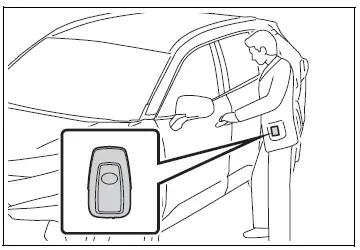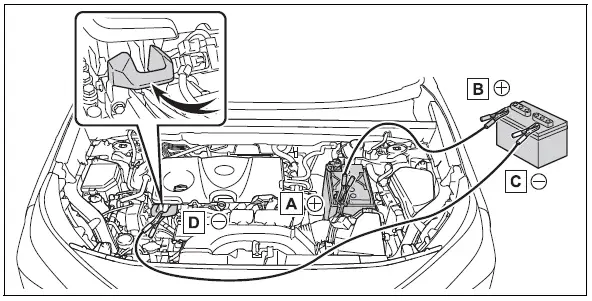Toyota RAV4 (XA50) 2019-2025 Owners Manual: If the vehicle battery is discharged
The following procedures may be used to start the engine if the vehicle's battery is discharged.
You can also call your Toyota dealer or a qualified repair shop.
Restarting the engine
If you have a set of jumper (or booster) cables and a second vehicle with a 12-volt battery, you can jump start your vehicle by following the steps below.
1. Vehicles with alarm system: Confirm that the electronic key is being carried.
When connecting the jumper (or booster) cables, depending on the situation, the alarm may activate and the doors locked.

2. Open the hood.
3. Connect a positive jumper cable clamp to A on your vehicle and connect the clamp on the other end of the positive cable to B on the second vehicle. Then, connect a negative cable clamp to C on the second vehicle and connect the clamp at the other end of the negative cable to D.
Use jumper cables that can reach the specified terminals and connecting point.

- Positive (+) battery terminal (your vehicle)
- Positive (+) battery terminal (second vehicle)
- Negative (-) battery terminal (second vehicle)
- Metallic point shown in the illustration
4. Start the engine of the second vehicle. Increase the engine speed slightly and maintain at that level for approximately 5 minutes to recharge the battery of your vehicle.
5. Vehicles without smart key system: Maintain the engine speed of the second vehicle and start the engine of your vehicle.
Vehicles with smart key system: Maintain the engine speed of the second vehicle and start the engine of your vehicle by turning the engine switch to ON.
6. Once the vehicle's engine has started, remove the jumper cables in the exact reverse order from which they were connected.
Once the engine starts, have the vehicle inspected at your Toyota dealer as soon as possible.
â– Starting the engine when the battery is discharged
The engine cannot be started by push-starting.
â– To prevent battery discharge
- Turn off the headlights and the
audio system while the engine is stopped.
(Vehicles with Stop & Start system: Except when the engine is stopped due to the Stop & Start system)
- Turn off any unnecessary electrical components when the vehicle is running at a low speed for an extended period, such as in heavy traffic.
â– When the battery is removed or discharged
- Information stored in the ECU is cleared. When the battery is depleted, have the vehicle inspected at your Toyota dealer.
- Some systems may require initialization.
â– When removing the battery terminals
When the battery terminals are removed, the information stored in the ECU is cleared. Before removing the battery terminals, contact your Toyota dealer.
â– Charging the battery
The electricity stored in the battery will discharge gradually even when the vehicle is not in use, due to natural discharge and the draining effects of certain electrical appliances.
If the vehicle is left for a long time, the battery may discharge, and the engine may be unable to start. (The battery recharges automatically during driving.)
â– When recharging or replacing the battery (vehicles without smart key start system)
The engine may not start on the first attempt after the battery has recharged but will start normally after the second attempt. This is not a malfunction.
â– When recharging or replacing the battery (vehicles with smart key system)
- In some cases, it may not be possible to unlock the doors using the smart key system when the battery is discharged. Use the wireless remote control or the mechanical key to lock or unlock the doors.
- The engine may not start on the first attempt after the battery has recharged but will start normally after the second attempt. This is not a malfunction.
- The engine switch mode is memorized
by the vehicle. When the
battery is reconnected, the system
will return to the mode it was in
before the battery was discharged.
Before disconnecting the battery, turn the engine switch to OFF.
If you are unsure what mode the engine switch was in before the battery discharged, be especially careful when reconnecting the battery.
â– When the battery is removed or discharged (vehicles with Stop & Start system)
The Stop & Start system may not automatically stop the engine for up to an hour.
â– When replacing the battery
- Vehicles with Stop & Start system:
Use a genuine battery specifically designed for use with the Stop & Start system or a battery with equivalent specifications to a genuine battery. If an unsupported battery is used, Stop & Start system functions may be restricted to protect the battery.
Also, battery performance may decrease and the engine may not be able to restart. Contact your Toyota dealer for details.
- Use a battery that conforms to European regulations.
Type A:
Use a battery that the case size is same as the previous one (LN3), 20 hours rate capacity (20HR) is equivalent (65Ah) or greater, and performance rating (CCA) is equivalent (603A) or greater.
Type B:
Use a battery that the case size is same as the previous one (LN2), 20 hours rate capacity (20HR) is equivalent (60Ah) or greater, and performance rating (CCA) is equivalent (360A) or greater.
Type C:
Use a battery that the case size is same as the previous one (LN2), 20 hours rate capacity (20HR) is equivalent (60Ah) or greater, and performance rating (CCA) is equivalent (563A) or greater.
- If the sizes differ, the battery cannot be properly secured.
- If the 20 hour rate capacity is low, even if the time period where the vehicle is not used is a short time, the battery may discharge and engine may not be able to start.
For details, consult your Toyota dealer.
WARNING
â– When removing the battery terminals
Always remove the negative (-) terminal first. If the positive (+) terminal contacts any metal in the surrounding area when the positive (+) terminal is removed, a spark may occur, leading to a fire in addition to electrical shocks and death or serious injury.
â– Avoiding battery fires or explosions
Observe the following precautions to prevent accidentally igniting the flammable gas that may be emitted from the battery:
- Make sure each jumper cable is connected to the correct terminal and that it is not unintentionally in contact with any other than the intended terminal.
- Do not allow the other end of the jumper cable connected to the "+" terminal to come into contact with any other parts or metal surfaces in the area, such as brackets or unpainted metal.
- Do not allow the + and - clamps of the jumper cables to come into contact with each other.
â– Battery precautions
The battery contains poisonous and corrosive acidic electrolyte, while related parts contain lead and lead compounds. Observe the following precautions when handling the battery:
- When working with the battery, always wear safety glasses and take care not to allow any battery fluids (acid) to come into contact with skin, clothing or the vehicle body.
- Do not lean over the battery.
- In the event that battery fluid
comes into contact with the skin
or eyes, immediately wash the
affected area with water and
seek medical attention.
Place a wet sponge or cloth over the affected area until medical attention can be received.
- Always wash your hands after handling the battery support, terminals, and other batteryrelated parts.
- Do not allow children near the battery.
â– When replacing the battery
For information regarding battery replacement, contact your Toyota dealer.
NOTICE
â– When handling jumper cables
When connecting the jumper cables, ensure that they do not become entangled in the cooling fan or engine drive belt.
â– When connecting jumper cables
Make sure to connect jumper cables to the specified terminals and connecting point. Failure to do so may adversely affect the electronic devices or damage to them.
 If the electronic key does
not operate properly (vehicles
with smart key system)
If the electronic key does
not operate properly (vehicles
with smart key system)
If communication between
the electronic key and vehicle
is interrupted or the electronic key cannot
be used because the battery
is depleted, the smart key
system and wireless remote
control cannot be ...
 If your vehicle overheats
If your vehicle overheats
The following may indicate
that your vehicle is overheating.
The engine coolant temperature
gauge shows the red zone or a
loss of engine power is
experienced. (For example,
the vehicle speed doe ...
Other materials:
Disassembly
Remove radiator grille sub-assembly
Remove the 4 bolts and 4 nuts.
Detach the 6 claws and remove the radiator grille.
Remove no. 1 Radiator grille lower
Detach the 18 claws and remove the radiator grille.
Remove no. 2 Radiator grille lower
Detac ...
Checking and adding the
brake fluid
â– Checking fluid level
The brake fluid level should be
between the "MAX" and "MIN"
lines on the tank.
â– Adding fluid
1. Slide and lift up the rubber
strip to partly remove it as
shown.
2. Disconnect the claws and
remove the service cover.
3. Remove the reservoir cap.
4. Add brake fluid slowl ...
Driving assist systems
To help enhance driving safety and performance, the following
systems operate automatically in response to various driving
situations. Be aware, however, that these systems are supplementary
and should not be relied upon too heavily when operating
the vehicle.
Abs (anti-lock brake system)
Help ...
